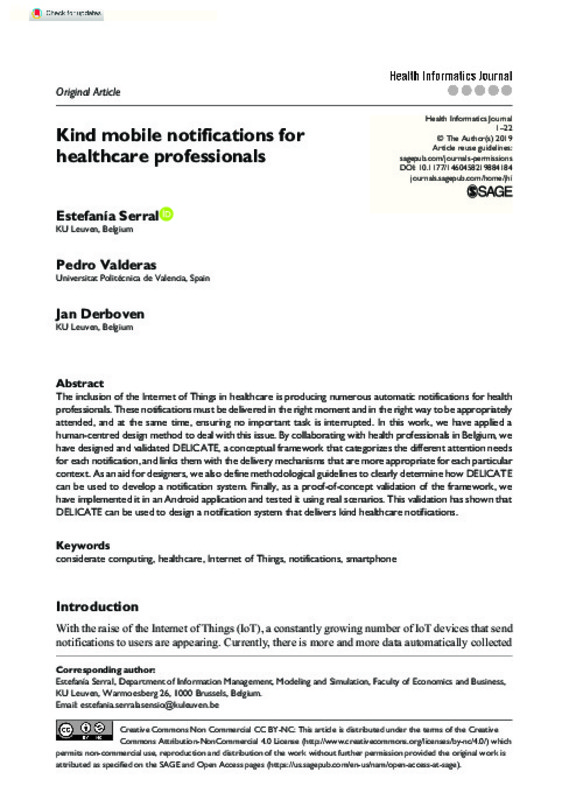JavaScript is disabled for your browser. Some features of this site may not work without it.
Buscar en RiuNet
Listar
Mi cuenta
Estadísticas
Ayuda RiuNet
Admin. UPV
Kind mobile notifications for healthcare professionals
Mostrar el registro sencillo del ítem
Ficheros en el ítem
| dc.contributor.author | Serral, Estefanía
|
es_ES |
| dc.contributor.author | Valderas, Pedro
|
es_ES |
| dc.contributor.author | Derboven, Jan
|
es_ES |
| dc.date.accessioned | 2020-12-23T04:31:34Z | |
| dc.date.available | 2020-12-23T04:31:34Z | |
| dc.date.issued | 2020-09 | es_ES |
| dc.identifier.issn | 1460-4582 | es_ES |
| dc.identifier.uri | http://hdl.handle.net/10251/157760 | |
| dc.description.abstract | [EN] The inclusion of the Internet of Things in healthcare is producing numerous automatic notifications for health professionals. These notifications must be delivered in the right moment and in the right way to be appropriately attended, and at the same time, ensuring no important task is interrupted. In this work, we have applied a human-centred design method to deal with this issue. By collaborating with health professionals in Belgium, we have designed and validated DELICATE, a conceptual framework that categorizes the different attention needs for each notification, and links them with the delivery mechanisms that are more appropriate for each particular context. As an aid for designers, we also define methodological guidelines to clearly determine how DELICATE can be used to develop a notification system. Finally, as a proof-of-concept validation of the framework, we have implemented it in an Android application and tested it using real scenarios. This validation has shown that DELICATE can be used to design a notification system that delivers kind healthcare notifications. | es_ES |
| dc.description.sponsorship | The author(s) disclosed receipt of the following financial support for the research, authorship and/or publication of this article: Pedro Valderas's work has been developed with the financial support of the Spanish State Research Agency under the project TIN2017-84094-R and co-financed with ERDF. Estefania Serral and Jan Derboven's work has been supported by IMEC funding. | es_ES |
| dc.language | Inglés | es_ES |
| dc.publisher | SAGE Publications | es_ES |
| dc.relation.ispartof | Health Informatics Journal | es_ES |
| dc.rights | Reconocimiento - No comercial (by-nc) | es_ES |
| dc.subject | Considerate computing | es_ES |
| dc.subject | Healthcare | es_ES |
| dc.subject | Internet of Things | es_ES |
| dc.subject | Notifications | es_ES |
| dc.subject | Smartphone | es_ES |
| dc.subject.classification | LENGUAJES Y SISTEMAS INFORMATICOS | es_ES |
| dc.title | Kind mobile notifications for healthcare professionals | es_ES |
| dc.type | Artículo | es_ES |
| dc.identifier.doi | 10.1177/1460458219884184 | es_ES |
| dc.relation.projectID | info:eu-repo/grantAgreement/AEI/Plan Estatal de Investigación Científica y Técnica y de Innovación 2013-2016/TIN2017-84094-R/ES/DISEÑO DE SISTEMAS AUTO-ADAPTATIVOS INVOLUCRANDO AL HUMANO/ | es_ES |
| dc.rights.accessRights | Abierto | es_ES |
| dc.contributor.affiliation | Universitat Politècnica de València. Departamento de Sistemas Informáticos y Computación - Departament de Sistemes Informàtics i Computació | es_ES |
| dc.description.bibliographicCitation | Serral, E.; Valderas, P.; Derboven, J. (2020). Kind mobile notifications for healthcare professionals. Health Informatics Journal. 26(3):1516-1537. https://doi.org/10.1177/1460458219884184 | es_ES |
| dc.description.accrualMethod | S | es_ES |
| dc.relation.publisherversion | https://doi.org/10.1177/1460458219884184 | es_ES |
| dc.description.upvformatpinicio | 1516 | es_ES |
| dc.description.upvformatpfin | 1537 | es_ES |
| dc.type.version | info:eu-repo/semantics/publishedVersion | es_ES |
| dc.description.volume | 26 | es_ES |
| dc.description.issue | 3 | es_ES |
| dc.identifier.pmid | 31702414 | es_ES |
| dc.relation.pasarela | S\403212 | es_ES |
| dc.contributor.funder | Agencia Estatal de Investigación | es_ES |
| dc.contributor.funder | European Regional Development Fund | es_ES |
| dc.description.references | Sasangohar, F., Donmez, B., Trbovich, P., & Easty, A. C. (2012). Not All Interruptions are Created Equal: Positive Interruptions in Healthcare. Proceedings of the Human Factors and Ergonomics Society Annual Meeting, 56(1), 824-828. doi:10.1177/1071181312561172 | es_ES |
| dc.description.references | McFarlane DC. Interruption of people in human-computer interaction: a general unifying definition of human interruption and taxonomy. Technical report, Office of Naval Research, Arlington VA, 31 December 1997. | es_ES |
| dc.description.references | Ross, D. T., & Schoman, K. E. (1977). Structured Analysis for Requirements Definition. IEEE Transactions on Software Engineering, SE-3(1), 6-15. doi:10.1109/tse.1977.229899 | es_ES |
| dc.description.references | Gulliksen, J., Göransson, B., Boivie, I., Blomkvist, S., Persson, J., & Cajander, Å. (2003). Key principles for user-centred systems design. Behaviour & Information Technology, 22(6), 397-409. doi:10.1080/01449290310001624329 | es_ES |
| dc.description.references | Beyer, H. R., & Holtzblatt, K. (1995). Apprenticing with the customer. Communications of the ACM, 38(5), 45-52. doi:10.1145/203356.203365 | es_ES |
| dc.description.references | Christel, M. G., & Kang, K. C. (1992). Issues in Requirements Elicitation. doi:10.21236/ada258932 | es_ES |








